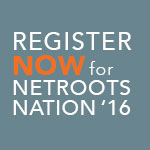After a great run, the Winning the Internet blog has been retired. However, you can still keep in touch with New Media Mentors here.
 As we gear up for Netroots Nation 2013, we’re taking a closer look at some of the convention’s hottest training sessions. We’re interviewing the trainers and taking you inside some of online activism’s most popular and elusive topics.
As we gear up for Netroots Nation 2013, we’re taking a closer look at some of the convention’s hottest training sessions. We’re interviewing the trainers and taking you inside some of online activism’s most popular and elusive topics.
Today we’re interviewing Chris Cassidy, who’ll be leading Kill the Press Release: Pitching Media in a New Media World.
NN13 Training Session
Kill the Press Release: Pitching Media in a New Media World
The press release was born in 1906, before the internet, mobile phones or television and just 10 years after the invention of radio. Since its birth, we’ve revolutionized the way we communicate. With everyone except media, that is. In 2013, most PR professionals rely on an expensive media database to produce their overly broad pitch lists, then blast that list with a one-size-fits-all message. This training will provide an overview on how to set goals, develop a pitch list without an expensive database and craft pitches that stand out in inboxes.
Interview
Q: Tell us about your media experience.
I jumped into media relations during law school, helping out a workforce housing campaign in San Francisco. Instead of spending my summer after law school studying for the bar exam, I worked as communications director for the 2008 campaign against an abortion ban in South Dakota. Since then, I’ve consulted on media relations for non-profits, progressive organizations and tech companies, and written for outlets like the American Prospect and Ms. Magazine.
Q: In your opinion, why is sending out a one-size fits all press release so problematic?
The press release is an ancient relic that may be more appropriate for the dustbin of history than a journalist’s crowded inbox. It was invented in 1906, when radios were brand new and there were only about 3 million telephones in the entire United States. Over 100 years later, we have unprecedented access to massive amounts of information and data. This permits organizations to tailor their communications, like online ads and emails, so that they use messages most likely to earn and keep the attention of their audience.
It’s bad enough to pitch a reporter with a one-size-fits-all message in a personally-tailored world. Beyond that, though, press releases are boring. They’re boring to write and they’re boring to read. Why torment the journalists you hope to engage with a formulaic message? In my mind, there is no excuse for not putting in the effort to pitch reporters with a message that reflects knowledge of their recent work and a respect for the many demands on their time and divided attention.
Q: What is the most important thing for folks to keep in mind when pitching media?
In thinking about public relations, many people seem to forget that journalists are not just a conduit to a broader audience. Journalists are people too — people with personal interests, bosses, deadlines, pet peeves and lots of other people vying for their attention.
There needs to be a golden rule of PR: Treat journalists as you wish to be treated. I’m not a huge fan of one-size-fits-all messages that don’t reflect an appreciation for my interests. I’m also not a big fan of receiving cold calls either. So why would I send journalists a press release, then follow-up with phone calls? To me, that sounds annoying and unimaginative.
Q: Why should folks attend your session at Netroots Nation, and how can they connect with you?
It’s going to ruffle some feathers, but the standard approach to public relations is way-hay-hay-haaay overdue for some changes. PR pros have used the same old formula for so long that it’s hard for most of us to imagine doing things any other way. In my years running Hustle Labs, I’ve helped dozens of organizations earn media coverage. I’ve handled public launches for companies, crafted the strategy for media regularly incorporating data from the world’s largest search engine, released microsites that received hundreds of thousands of hits, and earned extensive coverage of reports, videos, infographics and other content. And I’ve done it all writing fewer press releases than most PR professionals write in a single week.
I want to bring together people who are interested in thinking about a new approach to PR — an approach that follows the golden rule and treats journalists like the busy people that they are. I’m excited to share some of my guerrilla PR secrets publicly for the first time, and grateful to Netroots Nation for inviting me back to train the best and brightest minds in our movement.
Like any good fan of media, I’m easy to find where journalists are: Twitter. I tweet personally as @CitizenCassidy and professionally as @hustleis (which is also on Facebook here).
To attend this training, or one of the 39 others at Netroots Nation 2013 in San Jose, register now.




Comments are closed.